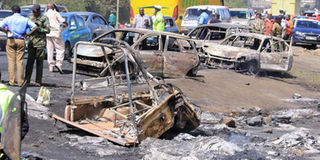Witnesses, survivors recall horrific scenes from accident that claimed 40

Remains of some of the vehicles involved in an accident at Karai area on Naivasha-Nakuru highway on December 11, 2016. The accident that occurred on Saturday night occured when a lorry transporting chemicals lost control and rammed onto other vehicles before it exploded, leaving 38 people dead. PHOTO | JEFF ANGOTE | NATION MEDIA GROUP
What you need to know:
- Survivors describe the nightmare of fierce fire, mystery blasts and death on the road as the holiday season begins, while questions abound on killer roads and unregulated, dangerous cargo
The Saturday night horrific crash in which close to 40 people perished in an explosion at Karai near Naivasha has cast a pall on the country as Kenyans were preparing to commemorate Jamhuri Day today, a holiday that for many marks the beginning of the festive season.
“It was a scene straight from hell,” said Mr James Kamau, who survived horrific crash that involved 12 vehicles, 11 of which were reduced to ashes.
It all started when a Ugandan-registered light truck, which was carrying yet-to-be-identified flammable substances, exploded.
The truck, whose driver lost control of the vehicle after hitting a bump, crashed into vehicles heading towards Nairobi. Two of the vehicles were carrying GSU and Administration Police officers. Eleven GSU and three AP officers were among those who died.
According to one account, the truck was carrying adhesives, whose contents included toluene, alkyl phenolic resin, magnesium oxide, plinox TDX and chloroform, chemicals which are highly flammable.
If confirmed, this could explain why all the vehicles that collided with the truck either exploded or were thrown off the road. The fuel from the cars added to the blazes.
On Sunday, a dazed Mr Kamau stood next to his burnt out vehicle, one of the many that were reduced to shells in the inferno. “Sijawahi shuhudia kitu kama hii (I have never witnessed such a horrific scene),” he mumbled. “I saw a matatu tossed up in the air.”
Witnesses said the 14-seater matatu was the first to be hit.

A relative of the people who perished in Naivasha fire tragedy is consoled at Chiromo funeral parlour on December 11, 2016. PHOTO DENNIS ONSONGO | NATION MEDIA GROUP
One witness, Mr Jesse Kamau, said the passengers stood no chance of survival.
Although they screamed for a while, they all were deathly quiet shortly after. Dead.
ABSENCE OF ROAD SIGNAGE
“It is difficult to say what led to the accident, but I suspect the man didn’t know this road well,” he said.
On Sunday, government officials were still debating whether the presence of the bumps on the highway might have caused the accident. The verdict was that investigations will determine the true cause, but some said the absence of road signage may be culpable.
“Whoever might have removed the ‘bumps-ahead’ sign made a dangerous mistake,” said Mr Pius Masai, the deputy director of the Disaster Management Unit.
A motorist, who also identified himself as Kamau, said: “I attempted to reverse but hit the vehicle behind mine. The tongues of fire were fast and furious, people were screaming.”
He said that he saw a man running for his life as flames consumed him. “I’m not sure if he survived.”
Mr Kamau and his three passengers were lucky to escape from the fire but one of them, Mr Edwin Wafula, sustained hand burns after his jacket caught fire. Mr Wafula said: “I don’t know what happened. I heard the driver shouting that we leave the vehicle immediately.” He jumped out, a decision that saved his life.
Burnt bodies were strewn within a radius of 150 metres of the crash, with cars, in various stages of burning. More bodies were trapped in the cars with rescuers trying to retrieve them with whatever they could find. Charred bodies lay in the middle of the road with rescuers and wananchi drawn to the frightening spectacle stepping on them.
PEOPLE WEPT
Most of those who witnessed the tragedy wept, unable to come to terms with the chaotic scenes of death, pain and mayhem unfolding in front of their eyes.
The crash caused a major traffic tailback. Unaware of what had happened, agitated motorists walked for more than a kilometre to find out what was causing the jam. What they saw left them speechless. No eye was without tears. Theories of what caused the crash abounded as the Kenya Red Cross, which was among the first responders, trucked bodies to an overwhelmed Naivasha Hospital mortuary.
As the fires raged, boda boda operators abandoned their business to save people from the raging flames. Mr Moses Maina will be eternally grateful to them for saving his son’s life. He arrived at Karai in the early hours of Sunday a shell-shocked man. He had sent his son to Nairobi to deliver clothes. He feared the worst on learning that his son’s Toyota Mark II had been seen on fire.
“He had been trapped in the car. The doors couldn’t open and the fire was increasing,” he told the Nation. “They (boda boda) smashed the windows, cut the seat belts and yanked him out,” said the retired engineer. “It was by the grace of God. He sustained serious burns but he got out alive. We are hoping that he will get well.”
The official death toll had risen to 38 by Sunday evening after police officers retrieved a body from the wreckage of the truck that exploded. The World Health Organisation has described the Nairobi-Nakuru highway as among the most dangerous in the world.
Three Ugandans — the truck driver and two passengers — died in the accident. The driver was Mr Ben Ayabake while the two passengers were Mr Matia Maganda 28, and Ms Namakaile Jeniffer 23.






